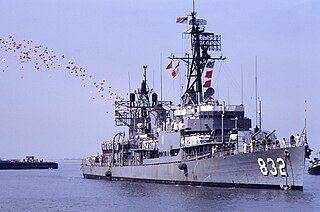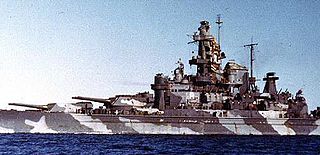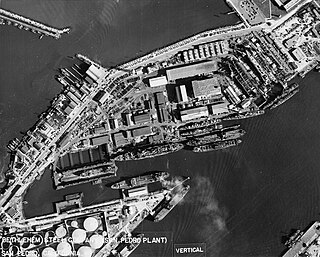Patterns
| Name | Description | Pattern sheet | Photo | Known examples |
|---|---|---|---|---|
| MS-32/1D | for Gridley (DD-380) and Bagley (DD-386) classes [lower-alpha 1] |  Port |  | Bagley, [lower-alpha 2] Helm, [lower-alpha 3] Mugford, [lower-alpha 4] Ralph Talbot |
| for Sims (DD-409) class | Port and starboard | Anderson | ||
| for Fletcher (DD-445) class | Port and starboard | Taylor, Mullaney, Bush, Hoel, [lower-alpha 3] Hall, Halligan, Newcomb | ||
| MS-32/3D | for Wickes (DD-75) and Clemson (DD-186) classes | Port and starboard | Lea, Badger, Breckinridge, [lower-alpha 5] [lower-alpha 6] Barney, DuPont, Bernadou, Cole, Bainbridge | |
| for Porter (DD-356) class [lower-alpha 7] | Port and starboard | Selfridge, [lower-alpha 8] Moffett, Phelps | ||
| for Mahan (DD-364) class | Port Starboard | Downes | ||
| for Somers (DD-381) class | Somers, Warrington, Sampson, Davis, Jouett | |||
| for Benham (DD-397) class | Mayrant, Trippe, Rhind | |||
| for Sims (DD-409) class | Russell, Wainwright | |||
| for Benson (DD-421) and Gleaves (DD-423) classes [lower-alpha 9] |  Port |  | Benson, Mayo, Niblack, [lower-alpha 5] Charles F. Hughes, Livermore, Eberle, Plunkett, Lansdowne, [lower-alpha 3] Mervine, Quick, Farenholt, Doyle, Endicott, McCook, [lower-alpha 3] Frankford, Kendrick, [lower-alpha 5] Laub, MacKenzie, Baldwin, Thompson, Cowie, Knight, Butler, Tillman, Rodman, [lower-alpha 5] Harding [lower-alpha 5] | |
| alternate for Benson (DD-421) and Gleaves (DD-423) classes [lower-alpha 10] | Buchanan, Kearny, [lower-alpha 3] Lardner, [lower-alpha 3] Boyle, Champlin [lower-alpha 5] | |||
| for Fletcher (DD-445) class | Radford, [lower-alpha 3] Haraden, [lower-alpha 3] Paul Hamilton, Hickox, McNair | |||
| for Allen M. Sumner (DD-692) class | Ingraham, Cooper, English, Walke, Laffey, O'Brien, Meredith, DeHaven, Mansfield, Hyman, Shannon, [lower-alpha 11] Adams, [lower-alpha 11] Brush, J. William Ditter [lower-alpha 11] | |||
| MS-31/6D | for Farragut (DD-348) class | Dewey, Hull, Dale, Aylwin | ||
| for Benson (DD-421) class | Woodworth, [lower-alpha 4] Bailey, Meade | |||
| MS-3_/6D | for Fletcher (DD-445) class |  |  | Jenkins (MS-32), Capps (MS-31), Ross (MS-32), Rowe (MS-31), Twiggs (MS-32), Bearss (MS-32), John Hood (MS-32), Monssen (MS-31), Colhoun (MS-32) |
| MS-31/7D | for Farragut (DD-348) class | Farragut, Monaghan [lower-alpha 4] | ||
| MS-32/7D | for Gamble (DM-15) class [lower-alpha 12] | Gamble, Preble, Sicard, Pruitt | ||
| for Chandler (DMS-9) class [lower-alpha 13] | Dorsey, Hovey, Hamilton | |||
| MS-3_/7D | for Fletcher (DD-445) class |  |  | Waller (MS-32), Pringle (MS-32), Evans (MS-31), Porterfield (MS-32), Callaghan (MS-31), Cassin Young (MS-32) |
| for Allen M. Sumner (DD-692) class | ||||
| MS-31/9D | for Fletcher (DD-445) class | Saufley, Van Valkenbugh, Cotton, Hopewell, Uhlmann | ||
| MS-32/9D | for Dunlap (DD-384) class | Dunlap, Fanning | ||
| for Allen M. Sumner (DD-692) class |  |  | Moale, Charles S. Perry, Ault, Waldron, John W. Weeks, Wallace L. Lind, Lyman K. Swenson, Maddox, Blue, Taussig | |
| MS-3_/10D | for Fletcher (DD-445) class |  | Daly (MS-32), Boyd (MS-31), Stembel (MS-32), Bullard (MS-31), Kidd (MS-31) | |
| MS-31/11D | for Sims (DD-409) and other single-stack classes |  |  | Ellet, Stack, [lower-alpha 4] Sterett, [lower-alpha 4] Hughes |
| for Fletcher (DD-445) class | Fullam, Watts, Killen, Metcalf, [lower-alpha 4] Hale, Chauncey, [lower-alpha 4] Jarvis, Gregory, Rooks [lower-alpha 4] | |||
| MS-32/13D | for Fletcher (DD-445) class |  |  | Hudson, Stanly, Anthony, Kimberly, Morrison, Prichett, Robinson, Sproston, Cogswell, Knapp, Bennion, Richard P. Leary, McGowan, Picking, Halsey Powell, Norman Scott, Irwin, Preston, Porter |
| MS-3_/14D | for Fletcher (DD-445) class |  |  | Terry (MS-31), Wadsworth (MS-32), Aulick (MS-32), Charles Ausburne (MS-32), McKee (MS-32), Wickes (MS-32), William D. Porter (MS-32), Lewis Hancock (MS-32), Marshall (MS-32) |
| MS-31/16D | for Fletcher (DD-445) class | Leutze, Isherwood, Hailey, Smalley, Stoddard, Claxton, [lower-alpha 4] Dyson, Young, Hart, Braine, Hunt, Cushing, Little | ||
| for Allen M. Sumner (DD-692) class |  |  | Allen M. Sumner, Haynsworth, Hank, Gainard, Barton, Laffey, Collett, [lower-alpha 4] Harry F. Bauer, [lower-alpha 11] Tolman, [lower-alpha 11] [lower-alpha 4] Harry E. Hubbard, Lowry | |
| MS-32/16D | for Benson (DD-421) and Gleaves (DD-423) classes [lower-alpha 10] | Meade, Edwards, Thorn | ||
| MS-32/18D | for Fletcher (DD-445) class |  Starboard |  | Foote, Luce, Heywood L. Edwards |
| MS-31/21D | for Dahlgren (DD-187) class [lower-alpha 14] |  | Thornton | |
| for Fletcher (DD-445) class | Ringgold, Conway, Cony, Healy | |||
| MS-32/21D | for Fletcher (DD-445) class | Beale, Twining, Bradford, John D. Henley, Longshaw, Burns, Albert W. Grant, Stockham | ||
| MS-31/22D | for Fletcher (DD-445) class |  | Howorth, Wedderburn | |
| MS-32/22D | for Porter (DD-364) class [lower-alpha 7] | Selfridge [lower-alpha 8] | ||
| MS-31/23D | for Mahan (DD-364) class |  | Mahan, Cummings, Drayton, Lamson, Flusser, Reid, Conyngham, Smith | |
| for Fletcher (DD-445) class | O'Bannon, McCord, Wren, Bryant, [lower-alpha 4] Hickox [lower-alpha 4] | |||
| MS-32/23D | for Benson (DD-421) class [lower-alpha 15] | Frazier, Kalk | ||
| MS-32/24D | for Fletcher (DD-445) class |  | Nicholas, Ammen, Hazlewood, Heermann | |
| MS-31/25D | for Allen M. Sumner (DD-692) class |  | Borie, Walke, Purdy, Massey, Robert H. Smith, [lower-alpha 4] [lower-alpha 11] Thomas E. Fraser, [lower-alpha 4] [lower-alpha 11] Henry A. Wiley, [lower-alpha 4] [lower-alpha 11] Shea, [lower-alpha 4] [lower-alpha 11] Gwin [lower-alpha 4] [lower-alpha 11] | |
| MS-33a/27D | for Allen M. Sumner (DD-692) class |  | Alfred A. Cunningham | |
| MS-33a/28D | for Gearing (DD-710) class |  | Gearing, Frank Knox, Southerland, Chevalier | |
| MS-33a/30D | for Allen M. Sumner (DD-692) class |  | John R. Pierce | |
| Adapted patterns | ||||
| MS-32/11A (aircraft carrier) | adapted to Allen M. Sumner (DD-692) class |  |  | Compton, Soley, Mannert L. Abele, Drexler, Samuel N. Moore, Putnam, Willard Keith, Lindsey, Aaron Ward |
| MS-31/2C (cruiser) | adapted to Fletcher (DD-445) class | Fletcher, Converse, Spence, Thatcher, Yarnall, [lower-alpha 4] Harrison, Charles J. Badger, Benham | ||
| MS-32/2C (cruiser) | adapted to Sims (DD-409) and other single-stack classes | Patterson, Morris | ||












